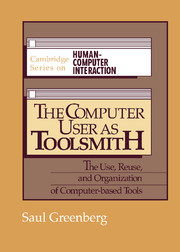Book contents
- Frontmatter
- Contents
- List of figures
- List of tables
- Foreword
- Acknowledgments and dedication
- 1 Introduction
- 2 Studying UNIX
- 3 Using commands in UNIX
- 4 Techniques for reusing activities
- 5 Recurrent systems
- 6 Reuse opportunities in UNIX csh – potential and actual
- 7 Principles, corroboration, and justification
- 8 Organizing activities through workspaces
- 9 A workspace system: description and issues
- 10 Conclusion
- Appendix A A sample trace
- Appendix B Summary statistics for each subject
- References
- Author index
- Subject index
5 - Recurrent systems
Published online by Cambridge University Press: 26 May 2010
- Frontmatter
- Contents
- List of figures
- List of tables
- Foreword
- Acknowledgments and dedication
- 1 Introduction
- 2 Studying UNIX
- 3 Using commands in UNIX
- 4 Techniques for reusing activities
- 5 Recurrent systems
- 6 Reuse opportunities in UNIX csh – potential and actual
- 7 Principles, corroboration, and justification
- 8 Organizing activities through workspaces
- 9 A workspace system: description and issues
- 10 Conclusion
- Appendix A A sample trace
- Appendix B Summary statistics for each subject
- References
- Author index
- Subject index
Summary
Schemes for activity reuse are based upon the assumption that the human–computer dialog has many recurring activities. Yet there is almost no empirical evidence confirming the existence of these recurrences or suggestions of how observed patterns of recurrences in one dialog would generalize to other dialogs. The next few chapters address this dearth. They provide empirical evidence that people not only repeat their activities, but that they do so in quite regular ways. This chapter starts with the general notion of recurrent systems, where most users predominantly repeat their previous activities. Such systems suggest potential for activity reuse because there is opportunity to give preferential treatment to the large number of repeated actions. A few suspected recurrent systems from both non-computer and computer domains are examined in this context to help pinpoint salient features. Particular attention is paid to repetition of activities in telephone use, information retrieval in technical manuals, and command lines in UNIX. The following chapters further examine UNIX as a recurrent system, and then generalize the results obtained into a set of design properties.
A definition of recurrent systems
An activity is loosely defined as the formulation and execution of one or more actions whose result is expected to gratify the user's immediate intention. It is the unit entered into incremental interaction systems (as defined in Section 1.2.1) (Thimbleby, 1990). Entering command lines, querying databases, and locating and selecting items in a menu hierarchy are some examples.
Information
- Type
- Chapter
- Information
- The Computer User as ToolsmithThe Use, Reuse and Organization of Computer-Based Tools, pp. 65 - 83Publisher: Cambridge University PressPrint publication year: 1993
Accessibility standard: Unknown
Why this information is here
This section outlines the accessibility features of this content - including support for screen readers, full keyboard navigation and high-contrast display options. This may not be relevant for you.Accessibility Information
- 1
- Cited by
